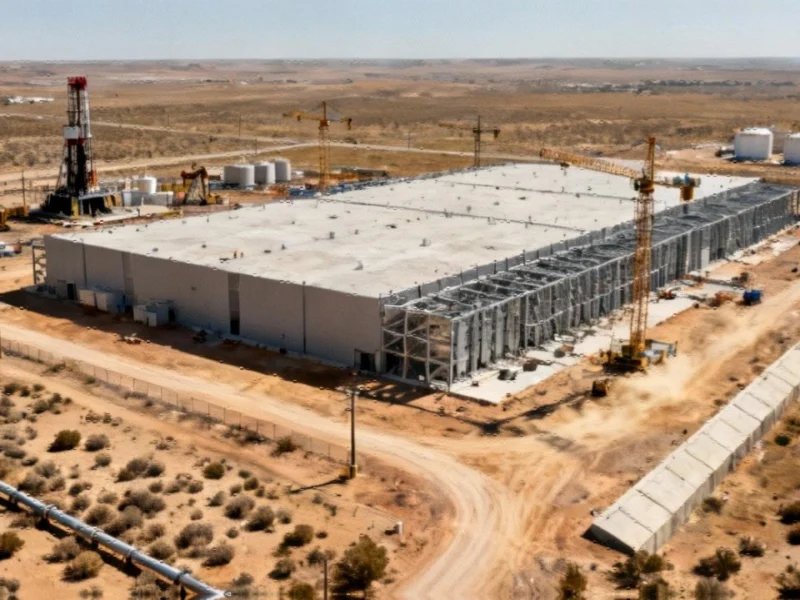Note: Featured image is for illustrative purposes only and does not represent any specific product, service, or entity mentioned in this article.
AI’s Power Hunger Reshapes Energy Landscape
The rapid expansion of artificial intelligence is creating unexpected consequences in America’s energy sector, with major technology companies increasingly turning to fracked natural gas to power their data centers, according to industry reports. This trend represents a surprising revival for the natural gas industry, which climate advocates had previously criticized for environmental concerns including water contamination and induced seismic activity.
Sources indicate that AI companies are constructing massive computing facilities near major gas production sites, often generating their own power by tapping directly into fossil fuel sources. This development has been largely overshadowed by more optimistic narratives about AI’s potential benefits but is raising difficult questions for the communities hosting these energy-intensive operations.
Texas Becomes Ground Zero for AI Energy Expansion
Analysts point to West Texas as a focal point for this emerging trend. Recent reports describe how AI coding assistant startup Poolside is developing a data center complex spanning more than 500 acres approximately 300 miles west of Dallas. The facility, dubbed Horizon, will reportedly generate two gigawatts of computing power—equivalent to the Hoover Dam’s entire electric capacity—by burning natural gas extracted from the Permian Basin, where hydraulic fracturing dominates energy production.
Poolside is reportedly collaborating with cloud computing company CoreWeave on the project, which will provide access to more than 40,000 Nvidia AI chips. Industry observers have characterized the development as an “energy Wild West” as companies race to secure power for their AI ambitions.
Major Players Embrace Gas-Powered Computing
Poolside is far from alone in this strategy, according to industry analysts. Last month, OpenAI CEO Sam Altman reportedly toured his company’s flagship Stargate data center in Abilene, Texas, where he acknowledged they were “burning gas to run this data center.” The Associated Press reported the complex requires approximately 900 megawatts of electricity across eight buildings and includes a new gas-fired power plant using turbines similar to those that power warships.
While companies claim these plants primarily provide backup power with most electricity coming from local grids, those grids themselves draw significantly from natural gas sources, mixed with West Texas’s substantial wind and solar farms. The scale of these developments represents a significant shift in how technology companies approach their energy needs.
Community Impacts and Environmental Concerns
Local residents living near these projects report significant disruptions to their quality of life. Arlene Mendler, who lives across from the Stargate facility, told the Associated Press that bulldozers eliminated a huge tract of mesquite shrubland to make room for construction, completely changing the way her community lives. She moved to the area 33 years ago seeking “peace, quiet, tranquility” but now contends with constant construction noise and bright lights that have spoiled her nighttime views.
Water consumption represents another major concern in drought-prone regions. While companies like Oracle claim their closed-loop cooling systems will require minimal water after initial filling, researchers suggest these assessments can be misleading. Shaolei Ren, a University of California, Riverside professor who studies AI’s environmental footprint, told the AP that systems requiring more electricity inevitably lead to greater indirect water consumption at the power plants generating that electricity.
National Expansion Beyond Texas
The trend extends beyond Texas, with Meta Platforms planning a $10 billion data center in Richland Parish, Louisiana—the state’s poorest region—that will require two gigawatts of power for computation alone. Utility company Entergy will spend $3.2 billion to build three large natural-gas power plants with 2.3 gigawatts of capacity to feed the facility by burning gas extracted through fracking in the nearby Haynesville Shale.
Even Elon Musk’s xAI has connections to fracking, according to reports. Memphis Light, Gas and Water—which currently sells power to xAI but will eventually own the substations xAI is building—purchases natural gas on the spot market and pipes it to Memphis via companies connected to hydraulically fractured shale formations.
Geopolitical Justifications and Policy Support
When questioned about the environmental implications, AI companies often frame their energy strategy in geopolitical terms. Chris Lehane, OpenAI’s vice president of global affairs, recently argued that the United States needs to generate approximately a gigawatt of energy weekly to compete with China’s massive energy buildout, which reportedly included 450 gigawatts and 33 nuclear facilities constructed in just one year.
The Trump administration has supported this approach through a July 2025 executive order that fast-tracks gas-powered AI data centers by streamlining environmental permits, offering financial incentives, and opening federal lands for projects using natural gas, coal, or nuclear power—while explicitly excluding renewables from support.
Questioning the Necessity of New Capacity
One key question largely absent from the conversation, according to analysts, is whether all this new capacity is actually necessary. A Duke University study found that utilities typically use only 53% of their available capacity throughout the year, suggesting significant room to accommodate new demand without constructing new power plants.
The researchers estimate that if data centers reduced electricity consumption by roughly half for just a few hours during annual peak demand periods, utilities could handle an additional 76 gigawatts of new load—effectively absorbing the 65 gigawatts data centers are projected to need by 2029. This flexibility could provide a reprieve from the rush to build natural gas infrastructure, giving utilities time to develop cleaner alternatives.
Long-Term Implications and Future Alternatives
Financial arrangements for these projects raise questions about long-term impacts. Meta has reportedly guaranteed it will cover Entergy’s costs for new Louisiana generation for 15 years, while Poolside’s lease with CoreWeave runs for a similar period. What happens to customers when these contracts expire remains uncertain, potentially leaving communities with expensive infrastructure and higher electricity bills.
Meanwhile, significant private investment is flowing into alternative energy solutions. Fusion startups like Helion and Commonwealth Fusion Systems have raised substantial funding from AI industry leaders, including Nvidia and Altman. The excitement has spilled into public markets, where non-revenue-generating energy companies have collectively ballooned in value based on expectations they will eventually power these data centers.
For now, the most immediate concern remains the impact on communities that never asked to become hubs for AI’s energy infrastructure. As construction continues across West Texas and other regions, residents face transformed landscapes and uncertain environmental futures while the industry pursues what it describes as geopolitical necessity. The situation illustrates how technological advancements can have unexpected consequences for local communities and energy markets, creating tensions between global ambitions and local realities.
As these industry developments continue to unfold, the balance between technological progress, environmental responsibility, and community impacts will likely remain a central challenge for both the AI sector and the communities hosting its infrastructure. The full consequences of this rapid expansion may not be understood for years, but the current trajectory suggests significant changes to both the energy landscape and the communities situated within it.
This article aggregates information from publicly available sources. All trademarks and copyrights belong to their respective owners.



